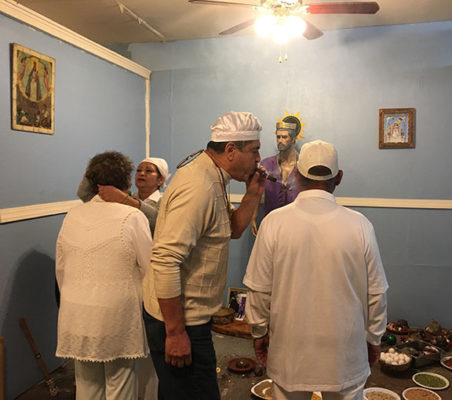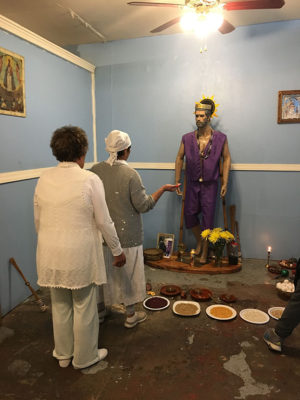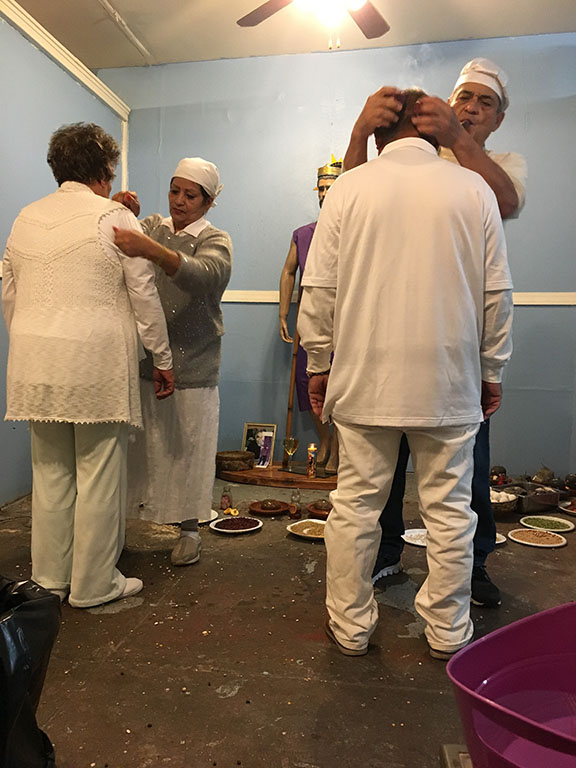As an 8-year-old child growing up in El Paso, I would frequently attend colorful family backyard barbeques that featured a small room lined with a row of chairs facing a table laid out with tiny cups and unusual statues of saints and Afro-Cuban dieties. In addition to enjoying the traditional barbeque food like hamburgers and hotdogs, my grandparents also served spicy black beans and rice, a dish they had learned to make when they visited Cuba some years ago.
Confused by the strange rituals I witnessed at these every-other-week family cookouts, which were far different from what I experienced at the Catholic church I attended with my parents on Sundays, I tended to keep my distance from the adults and instead spent my time running around the yard playing with my cousins.
 I didn’t pay much attention to why, at the family reunions, my grandparents and other relatives chanted in an unfamiliar language and dressed all in white. As a young Catholic, Mexican-American boy growing up in the U.S.-Mexico borderlands, all I understood was that the unfamiliar rituals were strange and foreign.
I didn’t pay much attention to why, at the family reunions, my grandparents and other relatives chanted in an unfamiliar language and dressed all in white. As a young Catholic, Mexican-American boy growing up in the U.S.-Mexico borderlands, all I understood was that the unfamiliar rituals were strange and foreign.
When I was 14 and a high school sophomore, I finally got up the nerve to ask one of my tias what religion my grandparents practiced. “Santeria,” she said, and went on to explain that, to her, the Afro Cuban practice is a sister to the Catholic religion.

Photo by Juan Corral
“We believe in the same beliefs, although we do a few things differently,” she said. “Other than going to church, we give ourselves spiritual cleanings. We believe in white magic and we believe in receiving our saints … all of which brings good energy, not only spiritually, but physically and mentally as well.”
Intrigued, I began to do a bit of research into Santeria, otherwise known as Regla de Ocha, which is defined as an Afro-Cuban religion. According to the BBC, the word Santeria comes from Spanish and loosely translates as devotion to the saints, or santos. Santeria, which is based on the beliefs of the African Yoruba people brought to Cuba as slaves hundreds of years ago, also incorporates some elements of Catholicism.
Santeria translates to the the way of the saints.
The religion includes many saints, or Orisha, of different powers and beliefs. For example, Oshún is the saint of love, beauty and femininity; Yemayá is similar to the Virgin Mary in Catholicism and brings unity within families. Changó represents justice and male beauty, along with passion and power.
I also learned that some people equate Santeria with witchcraft or brujeria, but according to religion experts this is a misunderstanding of the practice.

Recently, when I asked my grandparents, who met when they were both 36, how they came across this interesting religion they told me a very intriguing story. It turns out, my grandfather’s former wife had practiced black magic, and did not approve of her ex-husband’s new girlfriend, my now grandmother. The jealous ex wife began to use black magic practices against the couple, including placing unlit candles under their trailer, painting crosses in blood on the outside of their home, and discarding dead animals in the front yard.
At a loss on how to make the woman stop harrassing them, my grandma searched for someone who practiced Santeria white magic. They found a Santeria practicioner, an Indonesian man named Felipe, who taught them the practices. Eventually, the ex wife died.
Over the years my grandparents have delved further into Santeria. About 10-years-ago, they traveled to Cuba to receive what they call in Santeria their santos. To this day they continue to visit Cuba in June or July to be participate in various ceremonies. My grandfather will be going to Cuba this summer to become a Babalawo, a special ceremony to become a high priest.
One intriguing aspect of Santeria is invoking the spirit of someone who has died, at a religious ceremony called a Misa Espiritual (Spiritual Mass). During these masses, the practitioner becomes a spirituista and channels the spirit of the deceased who then provides recipes, fortunes, and advice.

Deciding whether or not to believe in another religion such as Santeria is totally up to the individual but respecting it is meaningful to those who practice it.
Another practice is a house cleanse, when a spiritual practitioner carries sage or yerbas, and starts at the front of the house, ending in the back of the house. The lit sage is wafted around the house, along with agua bendita (holy water) or agua florida. The liquids are used to clean the house of negative energies.
Although I have never followed the religion, I believe in my family. I believed the stories of those people whose lives they saved through the practice. Once, I went with my grandma and tias’ to a house cleaning where the atmosphere of the house felt heavy but as they walked through the house with the lit sage and sprinkled the water I could feel a change.
I realize now that what matters most to me and makes me feel proud is that my relatives are happy because they have poured their heart and soul into something they believe in.
I may not truly embrace the religion of Santeria like the rest of my famiily does, but I do respect it and them.


